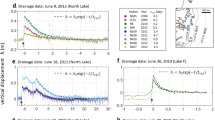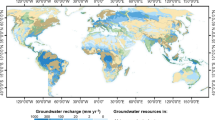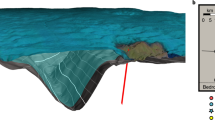Abstract
In the course of the transfer of precipitation into rivers, water is temporarily stored in reservoirs with different residence times1,2 such as soils, groundwater, snow and glaciers. In the central Himalaya, the water budget is thought to be primarily controlled by monsoon rainfall, snow and glacier melt3,4, and secondarily by evapotranspiration3. An additional contribution from deep groundwater5,6,7 has been deduced from the chemistry of Himalayan rivers6, but its importance in the annual water budget remains to be evaluated. Here we analyse records of daily precipitation and discharge within twelve catchments in Nepal over about 30 years. We observe annual hysteresis loops—that is, a time lag between precipitation and discharge—in both glaciated and unglaciated catchments and independent of the geological setting. We infer that water is stored temporarily in a reservoir with characteristic response time of about 45 days, suggesting a diffusivity typical of fractured basement aquifers8. We estimate this transient storage capacity at about 28 km3 for the three main Nepal catchments; snow and glacier melt contribute around 14 km3 yr−1, about 10% of the annual river discharge. We conclude that groundwater storage in a fractured basement influences significantly the Himalayan river discharge cycle.
This is a preview of subscription content, access via your institution
Access options
Subscribe to this journal
Receive 12 print issues and online access
$259.00 per year
only $21.58 per issue
Buy this article
- Purchase on Springer Link
- Instant access to full article PDF
Prices may be subject to local taxes which are calculated during checkout



Similar content being viewed by others
References
Alley, W. M., Healy, R. W., LaBaugh, J. W. & Reilly, T. E. Flow and storage in groundwater systems. Science 296, 1985–1990 (2002).
Oki, T. & Kanae, S. Global hydrological cycles and world water resources. Science 313, 1068–1072 (2006).
Bookhagen, B. & Burbank, D. W. Toward a complete Himalayan hydrological budget: Spatiotemporal distribution of snowmelt and rainfall and their impact on river discharge. J. Geophys. Res. 115, 1–25 (2010).
Scherler, D., Bookhagen, B. & Strecker, M. R. Spatially variable response of Himalayan glaciers to climate change affected by debris cover. Nature Geosci. 4, 156–159 (2011).
Anderson, S. P., Dietrich, W. E. & Brimhall, G. H. Weathering profiles, mass-balance analysis, and rates of solute loss: Linkages between weathering and erosion in a small, steep catchment. Geol. Soc. Am. Bull. 114, 1143–1158 (2002).
Tipper, E. et al. The short term climatic sensitivity of carbonate and silicate weathering fluxes: Insight from seasonal variations in river chemistry. Geochim. Cosmochim. Acta 70, 2737–2754 (2006).
Calmels, D. et al. Contribution of deep groundwater to the weathering budget in a rapidly eroding mountain belt, Taiwan. Earth Planet. Sci. Lett. 303, 48–58 (2011).
Montgomery, D. R. & Manga, M. Streamflow and water well responses to earthquakes. Science 300, 2047–2049 (2003).
Barros, A. P., Chiao, S., Lang, T. J., Burbank, D. & Putkonen, J. From weather to climate—Seasonal and interannual variability of storms and implications for erosion processes in the Himalaya. Geol. Soc. Am. Spec. Pap. 398, 17–38 (2006).
Andermann, C., Bonnet, S. & Gloaguen, R. Evaluation of precipitation data sets along the Himalayan front. Geochem. Geophys. Geosys. 12, Q07023 (2011).
Shrestha, M. L. Interannual variation of summer monsoon rainfall over Nepal and its relation to Southern Oscillation Index. Meteorol. Atmos. Phys. 75, 21–28 (2000).
Bookhagen, B., Thiede, R. & Strecker, M. Abnormal monsoon years and their control on erosion and sediment flux in the high, arid northwest Himalaya. Earth Planet. Sci. Let. 231, 131–146 (2005).
Immerzeel, W., Droogers, P., Dejong, S. & Bierkens, M. Large-scale monitoring of snow cover and runoff simulation in Himalayan river basins using remote sensing. Remote Sens. Environ. 113, 40–49 (2009).
Hannah, D., Kansakar, S., Gerrard, A. & Rees, G. Flow regimes of Himalayan rivers of Nepal: Nature and spatial patterns. J. Hydrol. 308, 18–32 (2005).
Bookhagen, B. & Burbank, D. W. Topography, relief, and TRMM-derived rainfall variations along the Himalaya. Geophys. Res. Lett. 33, L084505 (2006).
Putkonen, J. K. Continuous snow and rain data at 500 to 4400 m altitude near Annapurna, Nepal, 1999–2001. Arct. Antarct. Alpine Res. 36, 244–248 (2004).
Lambert, L. & Chitrakar, B. Variation of potential evapotranspiration with elevation in Nepal. Mountain Res. Dev. 9, 145–152 (1989).
Mouelhi, S., Michel, C., Perrin, C. & Andreassian, V. Stepwise development of a two-parameter monthly water balance model. J. Hydrol. 318, 200–214 (2006).
Wang, Q. J. et al. Monthly versus daily water balance models in simulating monthly runoff. J. Hydrol. 404, 166–175 (2011).
Bergström, S. in The HBV Model. Computer Models in Watershed Hydrology (ed. Singh, V. P.) 443–476 (Water Resources Publ., 1995).
Wittenberg, H. Baseflow recession and recharge as nonlinear storage processes. Hydrol. Process. 13, 715–726 (1999).
Dongol, B. S. et al. Shallow groundwater in a middle mountain catchment of Nepal: Quantity and quality issues. Environ. Geol. 49, 219–229 (2005).
De Marsily, G. Quantitative Hydrogeology: Groundwater Hydrology for Engineering (Academic, 1986).
Yatagai, A. et al. A 44-year daily gridded precipitation dataset for Asia based on a dense network of rain gauges. Sola 5, 137–140 (2009).
Hall, D. K., Riggs, A. G. & Salomonson, V. V. MODIS/Terra Snow Cover 8-Day L3 Global 0.05deg CMG V005, MOD10C2. National Snow and Ice Data Center. Digital media (2006 updated daily).
Mitchell, T. D. & Jones, P. D. An improved method of constructing a database of monthly climate observations and associated high-resolution grids. Int. J. Clim. 25, 693–712 (2005).
Bolch, T., Pieczonka, T. & Benn, D. I. Multi-decadal mass loss of glaciers in the Everest area (Nepal Himalaya) derived from stereo imagery. Cryosphere 5, 349–358 (2011).
Rodell, M. et al. The global land data assimilation system. Bull. Am. Meteorol. Soc. 85, 381–394 (2004).
National Snow and Ice Data Center. World glacier inventory. World Glacier Monitoring Service and National Snow and Ice Data Center/World Data Center for Glaciology. Digital media. (1999 updated 2009).
Department of Mines and Geology Nepal. Geological Map of Nepal. 1:1.000.000 (1994).
Acknowledgements
C.A. benefited from a three-year PhD scholarship awarded by the German Academic Exchange Service (DAAD, D/08/42538) and from the double PhD program of the French–German University Saarbrücken (DFH/UFA). The authors would like to thank K. P. Sharma and his team from the Department of Hydrology and Meteorology of Nepal (DHM) for providing hydrological data and M. Dhakal from ICIMOD Nepal for sharing their additional information on dug-well measurements.
Author information
Authors and Affiliations
Contributions
C.A. acquired and analysed the data. L.L. and C.A. performed the hydrological modelling. All authors discussed the results and wrote the manuscript.
Corresponding author
Ethics declarations
Competing interests
The authors declare no competing financial interests.
Supplementary information
Supplementary Information
Supplementary Information (PDF 883 kb)
Rights and permissions
About this article
Cite this article
Andermann, C., Longuevergne, L., Bonnet, S. et al. Impact of transient groundwater storage on the discharge of Himalayan rivers. Nature Geosci 5, 127–132 (2012). https://doi.org/10.1038/ngeo1356
Received:
Accepted:
Published:
Issue Date:
DOI: https://doi.org/10.1038/ngeo1356
This article is cited by
-
Multi-century (635-year) spring season precipitation reconstruction from northern Pakistan revealed increasing extremes
Scientific Reports (2024)
-
Effects of rainfall on fluvial discharge and suspended sediment transport in the Central Himalayan region, Nepal
Theoretical and Applied Climatology (2024)
-
Spring water system classifications and their methods of study: An overview of the current status and future perspectives
Journal of Earth System Science (2024)
-
Delineating hydro-geologically constrained groundwater zones in the Himalayan River basins of India through an innovative ensemble of hypsometric analysis and machine learning algorithms
Earth Science Informatics (2024)
-
Himalayan valley-floor widths controlled by tectonically driven exhumation
Nature Geoscience (2023)



